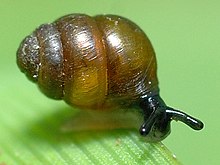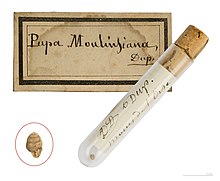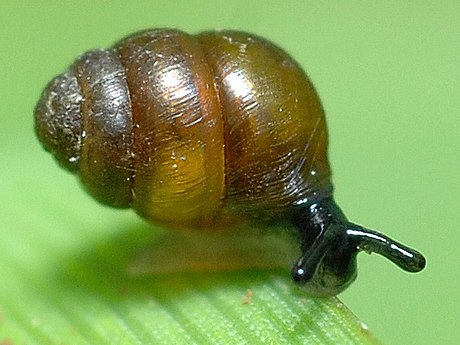Desmoulin's whorl snail (Vertigo moulinsiana) is a species of minute air-breathing land snail, a terrestrial pulmonate gastropod mollusc or micromollusc in the family Vertiginidae, the whorl snails.[3]
| Desmoulin's whorl snail | |
|---|---|
 | |
 | |
| Vertigo moulinsiana Holotype MHNT | |
| Scientific classification | |
| Domain: | Eukaryota |
| Kingdom: | Animalia |
| Phylum: | Mollusca |
| Class: | Gastropoda |
| Order: | Stylommatophora |
| Family: | Vertiginidae |
| Genus: | Vertigo |
| Species: | V. moulinsiana |
| Binomial name | |
| Vertigo moulinsiana | |
| Synonyms | |
| |
This species was named in honor of the early-19th-century French naturalist Charles des Moulins.
Habitat
Desmoulin's whorl snail inhabits calcareous wetlands, where there are tall sedges, saw-sedge (Cladium mariscus), reed-grass (Glyceria maxima) or the reed Phragmites australis.[4]

Distribution
The distribution of this species is Atlantic (the part of the Palearctic area which is under the direct climatic influence of the Atlantic Ocean), and southern-European.[5]
This small snail occurs across Europe as far north as southern Sweden.[6]
Within Western Europe, only the populations in England (Great Britain) and Ireland are considered to be viable,[6] although further populations exist in the Czech Republic (critically endangered, occupying the White Carpathians Biosphere Reserve, Kokořínsko Landscape Protected Area and Southern Moravia),[7][8][9] in Poland (critically endangered)[10] and elsewhere in Europe (for example: Netherlands,[11] France).[12] Its conservation status in the Czech Republic in 2004–2006 was described as favourable (FV) in the report for the European Commission in accordance with the Habitats Directive.[13] Its conservation status in Spain is endangered and it occurs in two localities only: near Estañá lake and near Lake of Banyoles.[14]
It is also found in Belgium, Switzerland, Italy, Germany, Austria, Slovakia, Hungary, Romania, Denmark, Norway, Finland, Latvia, Lithuania, Estonia, Belarus, Ukraine (Volhynia, critically endangered; around 2014 extinct in Crimea),[15][16] Russia, Georgia and Azerbaijan.[17] Its distribution also include Algeria and Morocco,[17] but it is possibly extinct in Algeria.[1]
This species is mentioned in Annex II of the European Union's Habitats Directive.[18]
Status in the United Kingdom
In the United Kingdom, Desmoulin's whorl snail is listed as endangered, although it occurs in a number of areas in a band from Norfolk to Dorset, with outlying populations in Kent and the Llŷn Peninsula in North Wales[6] and has probably been under-reported in the past because of its minute size. Its presence on the site of the planned Newbury bypass caused the building of that road to be postponed; the building works were able to go ahead once the snails had been moved to a new habitat nearby. It is reported to have since died out at the new site,[19][20] but the same report states "Desmoulin's whorl snail is now considered less scarce than it was 10 years ago".
Shell description
The shell is dextral, minute, ovate, ventricose, obtuse at the apex, smoothish, subperforate. The aperture is semiovate, four-toothed, with one tooth on the parietal wall, another on the columella, and two palatals, the lower one longer. The shell has four whorls, parted by a distinct suture, the last doubly larger than all the others together. It is rather solid, glossy, subpellucid and of a uniform fulvous color.[21]
The shell of this species reaches about 3 mm in length. The shell is yellowish or brownish and translucent.[22]
 |
 |
On a stamp
Deutsche Post featured V. moulinsiana on a 2002 German €0.51 postage stamp as part of a series on endangered species of animals.[23]
References
External links
Wikiwand in your browser!
Seamless Wikipedia browsing. On steroids.
Every time you click a link to Wikipedia, Wiktionary or Wikiquote in your browser's search results, it will show the modern Wikiwand interface.
Wikiwand extension is a five stars, simple, with minimum permission required to keep your browsing private, safe and transparent.

